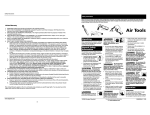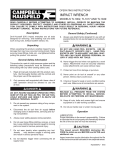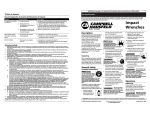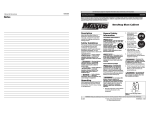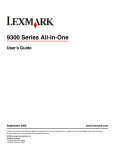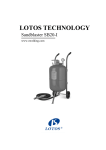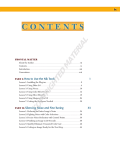Download Campbell Hausfeld Reference Design Instruction manual
Transcript
CAMPBELL HAUSFELD OPERATING INSTRUCTION MANUAL SANDBLASTING KITS MODELS AT125102AJ, AT121002AJ, AND AT121102AJ READ CAREFULLY BEFORE ATTEMPTING TO ASSEMBLE, INSTALL, OPERATE OR MAINTAIN THE PRODUCT DESCRIBED. PROTECT YOURSELF AND OTHERS BY OBSERVING ALL SAFETY INFORMATION. FAILURE TO COMPLY WITH INSTRUCTIONS COULD RESULT IN PERSONAL INJURY AND/OR PROPERTY DAMAGE! RETAIN INSTRUCTIONS FOR FUTURE REFERENCE. 7. Check hoses and air lines for weak or worn condition before each use. Make sure all connections are secure before use. Description Campbell Hausfeld sandblasting equipment is designed for cleaning and removing rust, scale, paint, grime and dirt for stripping, polishing and etching projects. This equipment can be used with sand, abrasive powders, or water and other liquids. ! WARNING ! DO NOT POINT THE SANDBLAST GUN AT ANYONE OR OBJECTS OTHER THAN THE INTENDED WORK OBJECT. 8. Do not depress the trigger when connecting the air supply hose. Unpacking After unpacking the sandblasting kit, carefully inspect for any damage that may have occurred during transit. Check for loose, missing or damaged parts. ! DANGER DO NOT WORK AROUND OILY RAGS OR FLAMMABLE LIQUIDS. SAND STRIKING METAL CAN CAUSE A SPARK AND CREATE A FIRE OR EXPLOSION. General Safety Information 1. Read this instruction manual before installing this device to the compressor pump. 2. Safety glasses or face shield, gloves and a respirator must be worn during operation. Always work in a well ventilated area. Figure 1 Figure 2 3. During operation, do not expose the hands or skin directly in the line of the blast nozzle. 4. After installation, inspect to make sure all components seal properly. 5. Keep children away at all times. All visitors must be kept a safe distance and wear safety glasses, gloves and a respirator. 6. Do not exceed the maximum operating pressure of the sandblasting equipment (125 PSI). ! WARNING ! DO NOT SPRAY ACIDS OR CAUSTICS. ! WARNING ! DISCONNECT THE SANDBLASTER FROM THE AIR SUPPLY BEFORE CHANGING ACCESSORIES OR ATTEMPTING TO INSTALL, SERVICE, RELOCATE OR PERFORM ANY MAINTENANCE. Figure 3 Copyright 1993, Campbell Hausfeld/Scott Fetzer Company IN241900AV __ 1 __ 1/93 MODELS AT125102AJ, AT121002AJ AND AT121102AJ IN241900AV Specifications MODEL NOZZLE HOPPER CAPACITY MAXIMUM PSI HP REQUIRED MINIMUM CFM AT125102AJ AT121002AJ AT121102AJ Ceramic Ceramic Ceramic 30 lbs 60 lbs 120 lbs 125 125 125 1 or more 2 or more 2 or more 2.2 @ 40 PSI 2.2 @ 40 PSI 2.2 @ 40 PSI Assembly HOSE CONNECT ASSEMBLY FOR MODEL AT125102AJ - 30 LBS 1. Attach the material hose to the hose connector. Attach the opposite end of the material hose to the gun (See Figure 4). NOTE: DO NOT cover the hole in the hose connector for dry blasting. For use with liquids, slip the material hose fully on the hose connector covering the hole. 2. Attach the air compressor hose to the opening at the bottom of the gun handle. An optional 1/4" NPT quick connector (MP2468) and coupler (MP2883) can be used to attach the hose to the gun. ATTACH AIR HOSE MATERIAL HOSE CONDUIT NUT MATERIAL HOSE DO NOT COVER THIS HOLE FOR DRY BLASTING HOSE CONNECTOR Figure 5 _ Model AT121002AJ - 60 LBS DO NOT COVER THIS HOLE FOR DRY BLASTING ATTACH AIR HOSE 3. Attach the material hose to the hose connector. Attach the opposite end of the material hose to the gun (See Figure 6). NOTE: DO NOT cover the hole in the hose connector for dry blasting. For use with liquids, slip the material hose fully on the hose connector covering the hole. 4. Attach the air compressor hose to the opening at the bottom of the gun handle. An optional 1/4" NPT quick connector (MP2468) and coupler (MP2883) can be used to attach the hose to the gun. HOSE CONNECTOR Figure 4 _ Model AT125102AJ - 30 LBS HOSE CONNECT ASSEMBLY FOR MODEL AT121002AJ - 60 LBS PROTRUDING HUB 1. Attach the hose connector to the hopper using the conduit nut. 2. Attach the material hose to the hose connector. Attach the opposite end of the material hose to the gun (See Figure 5). NOTE: DO NOT cover the hole in the hose connector for dry blasting. For use with liquids, slip the material hose fully on the hose connector covering the hole. 3. Attach the air compressor hose to the opening at the bottom of the gun handle. An optional 1/4" NPT quick connector (MP2468) and coupler (MP2883) can be used to attach the hose to the gun. WHEEL CAP ATTACH AIR HOSE HOPPER AND HOSE CONNECT ASSEMBLY FOR MODEL AT121102AJ - 120 LBS 1. Slide the wheel onto the axle and lightly hammer on the wheel cap. Make sure the protruding hub on the wheel is facing the hopper (See Figure 6). Repeat for the opposite side. 2. Attach the hose connector to the hopper using the conduit nut. MATERIAL HOSE HOSE CONNECTOR CONDUIT DO NOT NUT COVER THIS HOLE FOR DRY BLASTING Figure 6 _ Model AT121102AJ - 120 LBS __ 2 __ MODELS AT125102AJ, AT121002AJ AND AT121102AJ IN241900AV Installation Operation It is recommended that sandblasting equipment be used with commonly available sandblast cabinets. However, a temporary sandblasting booth can also be used. 1. Always wear a safety shield or safety glasses, gloves and a respirator when sandblasting. 2. Locate the compressor as far away as possible from the sandblasting area to minimize the dust in the compressor intake. MAKING A TEMPORARY SANDBLAST BOOTH To make a temporary sandblast booth, refer to Figure 7 and follow the outlined procedures below. 3. The higher the air pressure (maximum 125 PSI), and the closer to the work , the quicker the job will be done. Material needed: 1 roll of 3" plastic tape 1 large corrugated box 4 square feet of plexiglass 1/4 yard of old cloth 4. Use a large grit abrasive to remove material and use a small grit to smooth surfaces. 5. Always trial test the sandblaster to make sure the job is done without damage by testing on a hidden surface. 1. Cut a rectangular hole out of one side on the box to serve as a window opening. Leave a least a two inch border around the cutoff for strength. 2. Cut the plexiglass two inches wider than the cutoff dimensions. This will be the top of the booth. 3. Cut two five inch round holes in one or two of the other sides of the box for arm holes. 4. Cut two pieces of cloth approximately eight inches wide to act as a curtain for the arm holes. Tape the top of the cloth pieces to the inside of the box so that the cloth hangs over each hole. 5. Cut a 1-1/2 inch hole in the corner of the flaps on the open end of the box for the air and material hoses. 6. (OPTIONAL) Cut a small hole in the unopened end of the box for inserting a hole from a shop vacuum. This will aid in clearing dust and collecting sand for reuse. 6. Always filter (screen) the abrasive material to remove any caked material and prevent clogging. 7. Use a compressor that can supply enough air (See Specifications). A compressor too small will cause air pressure to drop and the sandblaster will not operate satisfactorily. 8. Do not try to spray heavy liquids. 9. When spraying devices such as carburetors, stuff rags or paper into all openings to prevent internal damage. 10. Use the lowest effective pressure on soft surfaces to prevent pitting the surface. 11. Whenever the nozzle is removed and replaced, use a brush to clean the threads and replace the o-ring. To use the sandblasting booth, put the booth on a work bench with an overhead light. Put the object to be sandblasted and the sandblast gun into the box. Tape the open end shut. PLEXIGLASS 2" 12. Soap and water can be used for cleaning purposes for automobiles, lawn chairs, etc. MOISTURE IN COMPRESSED AIR Moisture in compressed air will form into droplets as the air comes from the compressor pump. When humidity is high or when a compressor is in continuous use for an extended period of time, moisture will collect in the tank. When using a sandblast gun, this water will be carried from the tank through the hose and out of the gun as droplets mixed with the material being sprayed. 2" CLOTH 5" DIA HOLES FOR HANDS IMPORTANT: THIS CONDENSATION WILL CAKE THE SAND AND CLOG THE SANDBLASTING GUN. A CLOGGED GUN WILL NOT OPERATE. 11/2" A compressed air dryer and/or air line filter will help eliminate this moisture (MP2121) Figure 7 __ 3 __ MODELS AT125102AJ, AT121002AJ AND AT121102AJ IN241900AV Operation TYPE OF ABRASIVE (SIEVE/SIZE) APPLICATION Sand (20-40) General purpose use. Removing light rust and paint from metal, wood or other surfaces; wood finishing; metal cleaning; glass and stone etching; hole drilling in glass; brick or cement block cleaning; brass and silver cleaning; light brick cleaning; exterior automotive parts cleaning; light stone and cement removal and water deposit removal. Sand (50-100) Use for a fine polish finish or antique wood finish, brass and silver polishing, automotive parts cleaning and polishing, sheet metal surface polishing, and fine glass etching. Aluminum Oxide Corn Cob Meal Walnut or Pecan Shells (Ground) Heavy rust removal and rough surface paint removal Wood cleaning (fine) Wood cleaning (coarse) NOTE: Abrasive media that has not been cleaned and screened should be avoided, because the media could contain material that will clog the gun. Limited Warranty 1. DURATION: One year from the date of purchase by the original purchaser. 2. WHO GIVES THIS WARRANTY (WARRANTOR): Campbell Hausfeld The Scott Fetzer Company 100 Production Drive Harrison, Ohio 45030 Telephone: (513) 367-4811 3. WHO RECEIVES THIS WARRANTY (PURCHASER): The original purchaser (other than for purposes of resale) of the Campbell Hausfeld product. 4. WHAT PRODUCTS ARE COVERED BY THIS WARRANTY: Any Campbell Hausfeld portable air compressor, air tool or supplementary air accessory supplied or manufactured by Warrantor. 5. WHAT IS COVERED UNDER THIS WARRANTY: Defects on material and workmanship which occur within the duration of the warranty period. 6. WHAT IS NOT COVERED UNDER THIS WARRANTY: A. Implied warranties, including those of merchantability and FITNESS FOR A PARTICULAR PURPOSE ARE LIMITED TO ONE YEAR FROM THE DATE OF ORIGINAL PURCHASE. Some states do not allow limitations on how long an implied warranty lasts, so the above limitations may not apply to you. B. ANY INCIDENTAL, INDIRECT, OR CONSEQUENTIAL LOSS, DAMAGE, OR EXPENSE THAT MAY RESULT FROM ANY DEFECT, FAILURE, OR MALFUNCTION OF THE CAMPBELL HAUSFELD PRODUCT. Some states do not allow the exclusion or limitation of incidental or consequential damages, so the above limitation or exclusion may not apply to you. C. Any failure that results from an accident, purchaser’s abuse, neglect or failure to operate products in accordance with instructions provided in the owner’s manual(s) supplied with product. D. Normal adjustments which are explained in the owner’s manual(s) provided with the product. E. Items or service that are normally required to maintain the product, i.e. lubricants. 7. RESPONSIBILITIES OF WARRANTOR UNDER THIS WARRANTY: Repair or replace, at Warrantor’s option, products or components which have failed within duration of the warranty period. 8. RESPONSIBILITIES OF PURCHASER UNDER THIS WARRANTY: A. Deliver or ship the Campbell Hausfeld product or component to the nearest Campbell Hausfeld Authorized Service Center. Freight costs, if any, must be borne by the purchaser. B. Use reasonable care in the operation and maintenance of the products as described in the owner’s manual(s). 9. WHEN WARRANTOR WILL PERFORM REPAIR OR REPLACEMENT UNDER THIS WARRANTY: A. Repair or replacement will be scheduled and serviced according to the normal work flow at the servicing location, and depending on the availability of replacement parts. B. If the purchaser does not receive satisfactory results from the Authorized Service Center, the purchaser should contact the Campbell Hausfeld Product Service Department (see paragraph 2). This Limited Warranty gives you specific legal rights and you may also have other rights which vary from state to state. Printed in Taiwan __ 4 __ MODELS AT125102AJ, AT121002AJ AND AT121102AJ IN241900AV Suggested Uses TYPE OF ABRASIVE (SIEVE/SIZE) APPLICATION DISTANCE FROM WORK PSI Sand (30-50) Glass Beads Etching and Drilling Holes in Glass 1-4" 40-90 Sand (40) Ground Walnut Shells Antiquing or Weathering Wood 2-6" 40-90 1-6" 40-70 Sand (50-100) Wood Sanding Glass Beads and Refinishing Ground Walnut Furniture Shells SUGGESTIONS Move gun back and forth over the template in a brushing manner. Blast at a 90° angle. For fine polishing, use glass beads for the abrasive. For drilling holes, use 30 sieve sand Use brushing strokes and watch the abrasion rate carefully. Soft wood will wear faster than hardwood. Smaller grit sizes give a smoother finish. Start with low pressure and gradually build up pressure. Blast at a 45° angle Use brushing strokes and watch the abrasion rate carefully. Use walnut shells for coarse finishing and glass beads or fine sand for fine finishing. Blast at a 45° angle Sand (20-40) Cleaning Barbecue Grills and Iron Pots 1-4" 50-125 Use larger grit sand on a hidden area. If the base material is being damaged, use a smaller grit. Blast at a 80-90° angle Sand (20-40) Aluminum Oxide Cleaning Automotive Parts 1-4" 40-80 Be sure to mask any glass or painted surface that could be accidentally damaged. Blast at a 80-90° angle Sand (20-40) Cleaning and Stripping Masonry 1-4" 50-125 Ground Pecan or Walnut Shells & Corn Cob Meal Cleaning or Preparing for Paint 1-6" 40-125 Sand (20-50) Aluminum Oxide (50-80) Cleaning, Stripping Outdoor Equipment 1-3" 50-125 Technical Service For information regarding the operation or repair of this product, please call 1-800-543-6400 between 8 a.m. and noon or between 1 p.m. and 5 p.m. (EST), Monday through Friday for assistance. If you are calling from Ohio or outside the continental United States, please call collect, 1513-367-1182. Use a heavy grit sand with a sweeping overlapping stroke. Blast at a 80-90° angle Use brushing strokes and watch the abrasion rate carefully. Soft wood will wear faster than hard wood. Smaller grit sizes give a smoother finish. Start with low pressure and gradually build up pressure. Blast at a 45-60° angle Remove flaking paint first with wire brush, then sandblast with a heavy grit abrasive. Multiple layers of old paint should be scraped first. Prime immediately following sandblasting to prevent corrosion. Blast at a 45-60° angle Please provide following information: • Model Number • Serial Number (if any) • Part Description and Number as shown in Parts List. __ 5 __ Address parts correspondence to: Campbell Hausfeld 100 Production Drive Harrison, Ohio 45030 IN241900AV MODELS AT125102AJ, AT121002AJ AND AT121102AJ Troubleshooting Chart SYMPTOM POSSIBLE CAUSE(S) CORRECTIVE ACTION Low or no air pressure 1. Regulator set incorrectly 2. Pinched hose 3. Dirty compressor filter 1. Reset regulator 2. Straighten hose 3. Clean or replace filter Material not blasting from gun Clogged material hose Lower the pressure below 40 PSI. Firmly hold the gun tip flat against the ground and pull the trigger to force the material back out of the material hose Clogged gun 1. Damp or heavy material 1. Replace with dry abrasive.(Damp material can be dried and reused). 2. Water in air supply 2. Drain air tank and install air filter. See "Moisture in Compressed Air" box Gun will not shut off – trigger stuck Damaged o-rings Remove and replace o-rings Sputtering – low vacuum 1. Worn jet and/or nozzle 2. Abrasive buildup around jet/nozzle 1. Replace jet and/or nozzle 2. Remove nozzle and jet and clean. Make sure the threads are clean before replacing Sputtering – air/abrasive leaks at nozzle/jet area 1. Loose nozzle or jet 2. Damaged o-ring 1. Tighten nozzle or jet 2. Replace o-ring Sputtering – vacuum leak 1. Loose material hose 2. Damaged o-ring 1. Tighten material hose 2. Replace o-ring Sputtering – particle clogging Hose connector hole is covered Uncover hose connector hole __ 6 __ IN241900AV MODELS AT125102AJ, AT121002AJ AND AT121102AJ Service Notes __ 7 __ IN241900AV MODELS AT125102AJ, AT121002AJ AND AT121102AJ Service Notes __ 8 __








